Rolling Bearing Fault Diagnosis Based on EWT Sub-Modal Hypothesis Test and Ambiguity Correlation Classification
Abstract
:1. Introduction
2. Denoising Method Based on EWT and Hypothesis Test
2.1. Basic Principles of EWT
2.2. Filtering Method Based on EWT Sub-Modal Hypothesis Test
2.3. Simulation Experiment
3. Ambiguity Correlation Classifier
3.1. Ambiguity Correlation Theory
- (1)
- Calculate correlation function of the ambiguity function of the two signals x(t) and y(t)
- (2)
- Calculate the normalized correlation coefficient using correlation function, with mathematical expression shown as follows:
- (3)
- Take the correlation coefficient when τ = 0 or θ = 0
- (4)
- Calculate the ambiguity correlation coefficient
3.2. Basic Principles of Classifiers
4. Experimental Research
Experimental Data Collection
5. Conclusions
- (1)
- Using EWT to decompose the vibration signal, the exact component can be obtained, and the mode aliasing phenomenon can be eliminated compared with EMD decomposition.
- (2)
- The sub-modes of EWT are tested by Gaussian distribution hypothesis to identify Gaussian noise. This method does not have parameter selection and has good adaptability.
- (3)
- Aiming at the shortcomings of traditional BP and SVM classifiers, such as too many parameters and slow convergence speed, the proposed classifier does not need parameter settings, and the calculation is simple. The experimental results show that the classifier can monitor different working conditions of rolling bearings, and the recognition rate is higher than BP and SVM.
Author Contributions
Funding
Conflicts of Interest
References
- Laha, S.K. Enhancement of fault diagnosis of rolling element bearing using maximum kurtosis fast nonlocal means denoising. Measurement 2017, 100, 157–163. [Google Scholar] [CrossRef]
- Chen, X.W.; Feng, Z.P. Time-frequency analysis of torsional vibration signals in resonance region for planetary gearbox fault diagnosis under variable speed conditions. IEEE Access 2017, 5, 21918–21926. [Google Scholar] [CrossRef]
- Jiang, L.; Yin, H.; Li, X.; Tang, S. Fault diagnosis of rotating machinery based on multi sensor information fusion using svm and time-domain features. Shock Vib. 2014, 2014, 418178. [Google Scholar]
- Yuan, R.; Lv, Y.; Song, G. Multi-fault diagnosis of rolling bearings via adaptive projection intrinsically transformed multivariate empirical mode decomposition and high order singular value decomposition. Sensors 2018, 18, 1210. [Google Scholar] [CrossRef] [PubMed]
- Tiwari, R.; Gupta, V.K.; Kankar, P.K. Bearing fault diagnosis based on multi-scale permutation entropy and adaptive neuro fuzzy classifier. J. Vib. Control 2013, 21, 461–467. [Google Scholar] [CrossRef]
- Ge, M.; Wang, J.; Ren, X. Fault Diagnosis of Rolling Bearings Based on EWT and KDEC. Entropy 2017, 19, 633. [Google Scholar] [CrossRef]
- Zhao, H.; Pan, Z.; Ye, J. A rolling bearing compound fault diagnosis method based on nonlinear manifold. Mech. Transm. 2012, 7, 89–91. (In Chinese) [Google Scholar]
- Zhou, H.; Shi, T.; Liao, G.; Xuan, J.; Duan, J.; Su, L.; He, Z.; Lai, W. Weighted Kernel Entropy Component Analysis for Fault Diagnosis of Rolling Bearings. Sensors 2017, 17, 625. [Google Scholar] [CrossRef]
- He, Z.J.; Zi, Y.Y.; Meng, Q.F. Fault Diagnosis Principles of Non-Stationary Signal and Applications to Mechanical Equipment; Higher Education Press: Beijing, China, 2001; pp. 1–9. ISBN 704010284. [Google Scholar]
- Hao, R.; Lu, W.; Chu, F. Mathematical morphology extraction method for rolling bearing fault signals. Chin. J. Electr. Eng. 2008, 28, 65–70. (In Chinese) [Google Scholar]
- Li, C.; Zhang, X.; Zhou, D.; Guo, X.; Zhang, L. Fault diagnosis of rolling bearing based on bispectrum fuzzy clustering. J. Nantong Univ. (Nat. Sci. Ed.) 2014, 13, 32–36. [Google Scholar]
- Cai, J.H.; Hu, W.W.; Wang, X.H. Based on higher-order statistics, rolling bearing fault diagnosis method. J. Vib. Meas. Diagn. 2013, 33, 298–301. [Google Scholar]
- Azzalini, A.; Farge, M.; Kai, S. Nonlinear wavelet thresholding: A recursive method to determine the optimal denoising threshold. Appl. Comput. Harmon Aanl. 2005, 18, 177–185. [Google Scholar] [CrossRef]
- Kankar, P.K.; Sharma, S.C.; Harsha, S.P. Rolling element bearing fault diagnosis using wavelet transform. Neurocomputing 2011, 74, 1638–1645. [Google Scholar] [CrossRef]
- Kumar, A.; Kumar, R. Enhancing Weak Defect Features Using Undecimated and Adaptive Wavelet Transform for Estimation of Roller Defect Size in a Bearing. Tribol. Trans. 2017, 5, 60. [Google Scholar] [CrossRef]
- Luisier, F.; Blu, T. SURE-LET multichannel image denoising: Interscale orthonormal wavelet thresholding. IEEE Trans. Image Process. 2008, 17, 482–492. [Google Scholar] [CrossRef]
- Xu, Y.; Liang, F.; Zhang, G.; Xu, H. Image Intelligent Detection Based on the Gabor Wavelet and the Neural Network. Symmetry 2016, 8, 130. [Google Scholar] [CrossRef]
- Zhen, R.; Zhengping, Z.; Wenying, H. Denoising and detection of faulted motor signal based on best wavelet packet basis. Proc. CSEE 2002, 2, 53–57. [Google Scholar]
- Yang, P.; Yang, Q. Empirical Mode Decomposition and Rough Set Attribute Reduction for Ultrasonic Flaw Signal Classification. Int. J. Comput. Intell. Syst. 2014, 7, 481–492. [Google Scholar] [CrossRef] [Green Version]
- Deng, W.; Zhao, H.; Yang, X.; Dong, C. A Fault Feature Extraction Method for Motor Bearing and Transmission Analysis. Symmetry 2017, 9, 60. [Google Scholar] [CrossRef]
- Wang, W.; Chau, K.; Xu, D.; Chen, X.-Y. Improving forecasting accuracy of annual runoff time series using ARIMA based on EEMD decomposition. Water Resour. Manag. 2015, 29, 2655–2675. [Google Scholar] [CrossRef]
- Sun, J.; Xiao, Q.; Wen, J.; Wang, F. Natural gas pipeline small leakage feature extraction and recognition based on LMD envelope spectrum entropy and SVM. Measurement 2014, 55, 434–443. [Google Scholar] [CrossRef]
- Gilles, J. Empirical wavelet transforms. IEEE Trans. Signal Process 2013, 61, 3999–4010. [Google Scholar] [CrossRef]
- Stein, S. Algorithms for ambiguity function processing. IEEE Trans. Acoust. Speech Signal Process. 2003, 29, 588–599. [Google Scholar] [CrossRef]
- Zhang, L.; Yang, B.; Luo, M. Joint Delay and Doppler Shift Estimation for Multiple Targets Using Exponential Ambiguity Function. IEEE Trans. Signal Process. 2017, 65, 2151–2163. [Google Scholar] [CrossRef]
- Lyu, X.; Stove, A.; Gashinova, M.; Cherniakov, M. Ambiguity function of Inmarsat BGAN signal for radar application. Electron. Lett. 2016, 52, 1557–1559. [Google Scholar] [CrossRef]

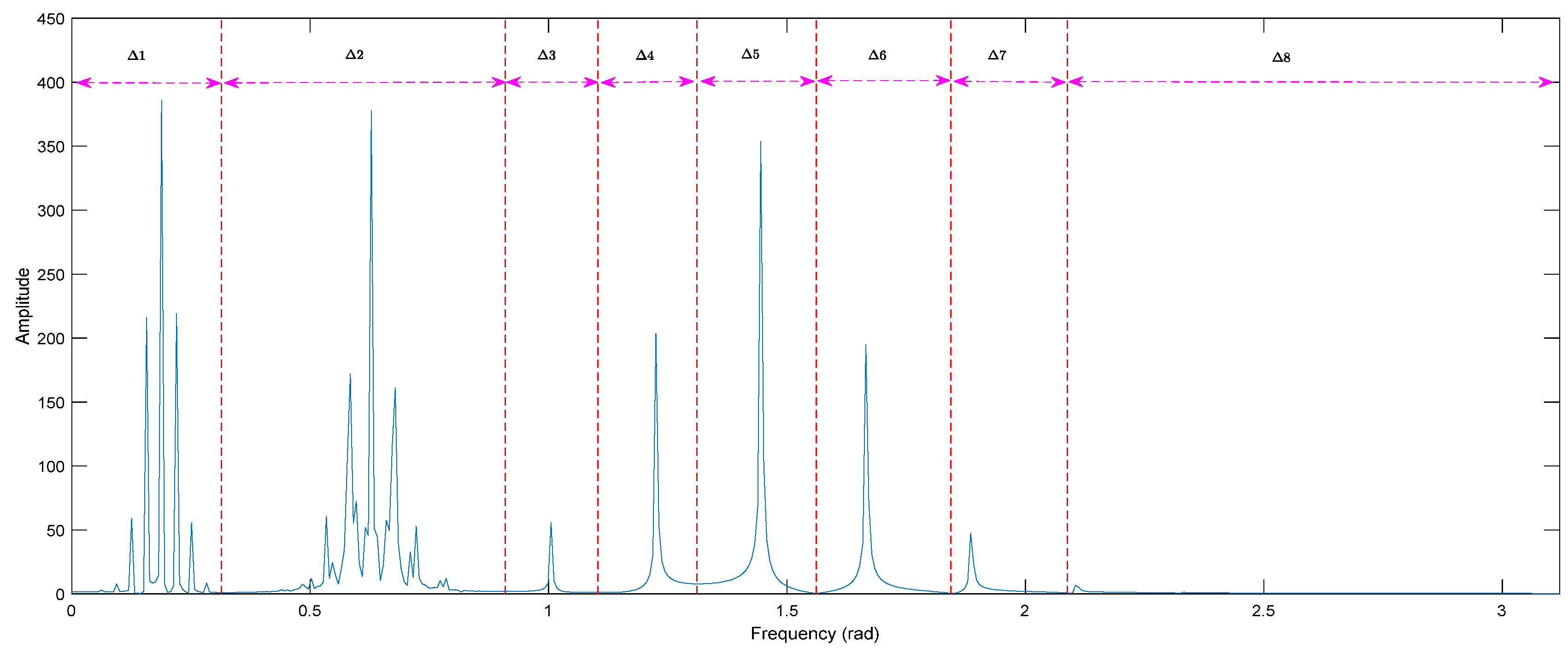
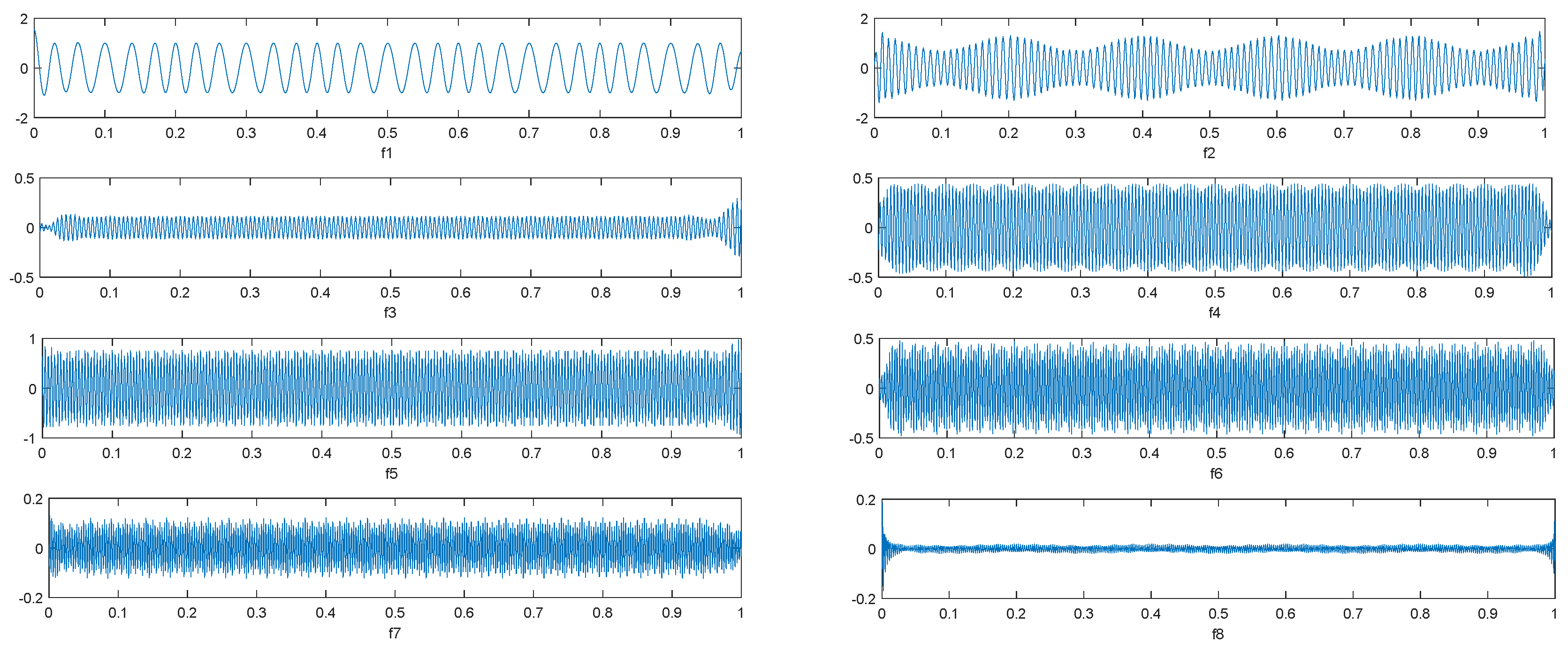

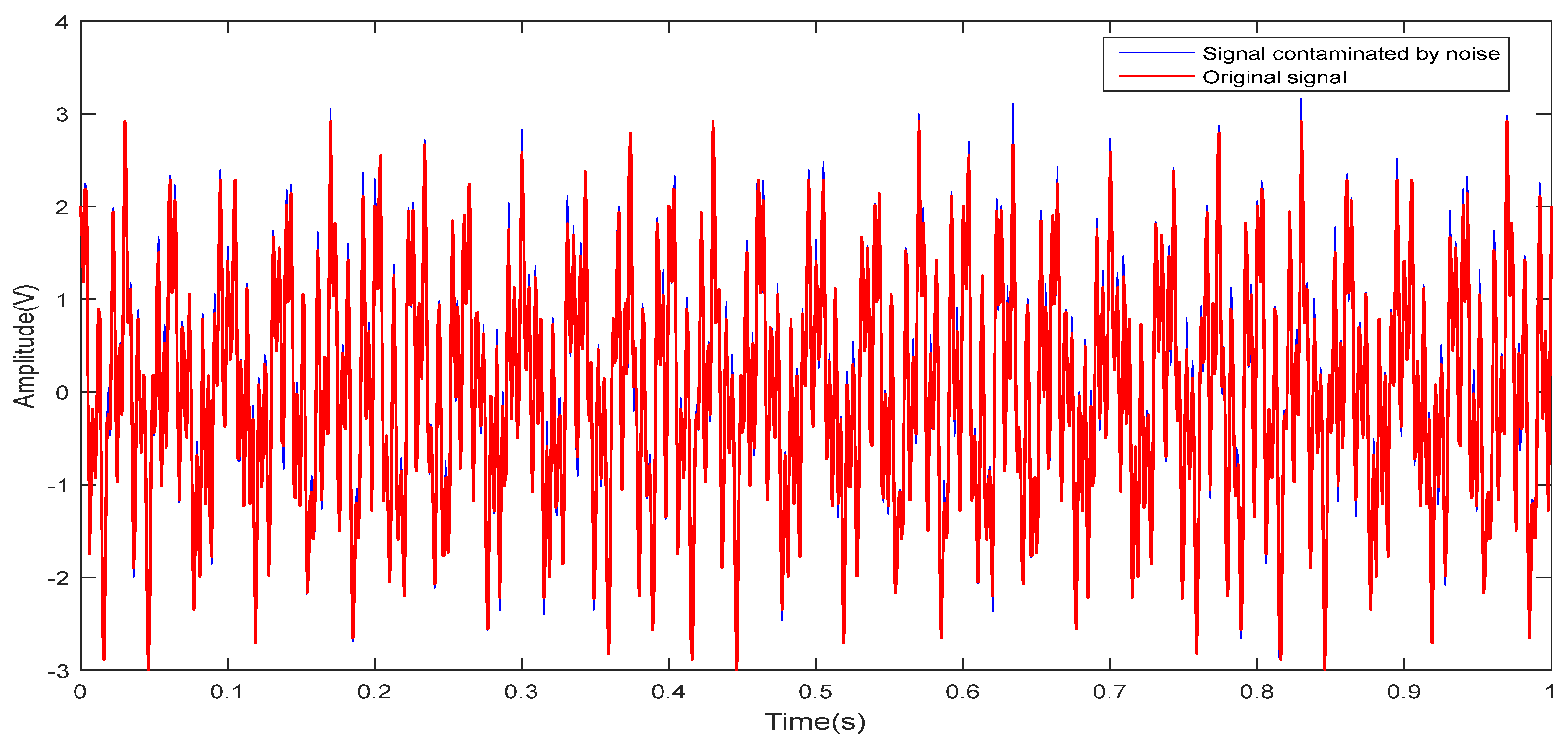
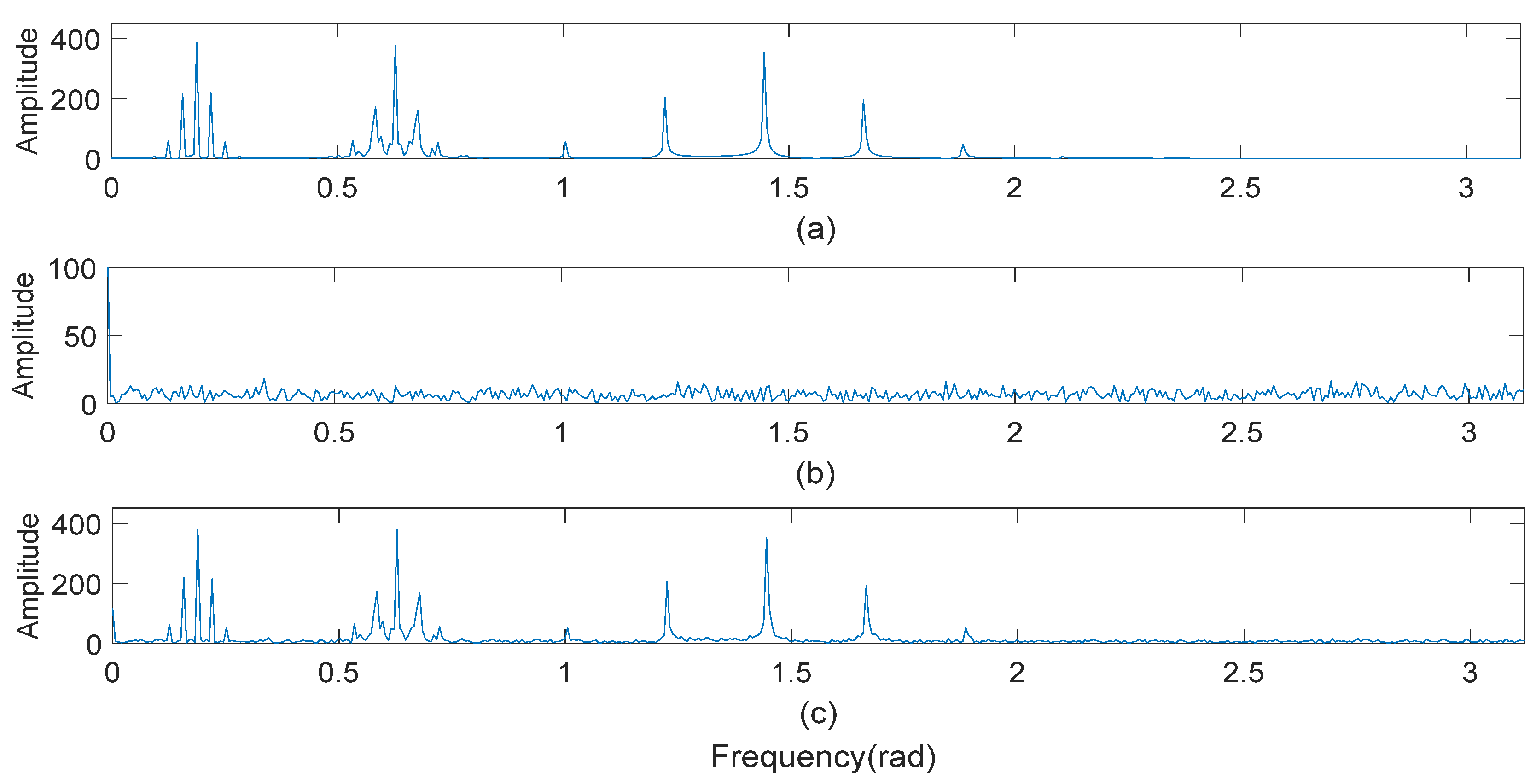
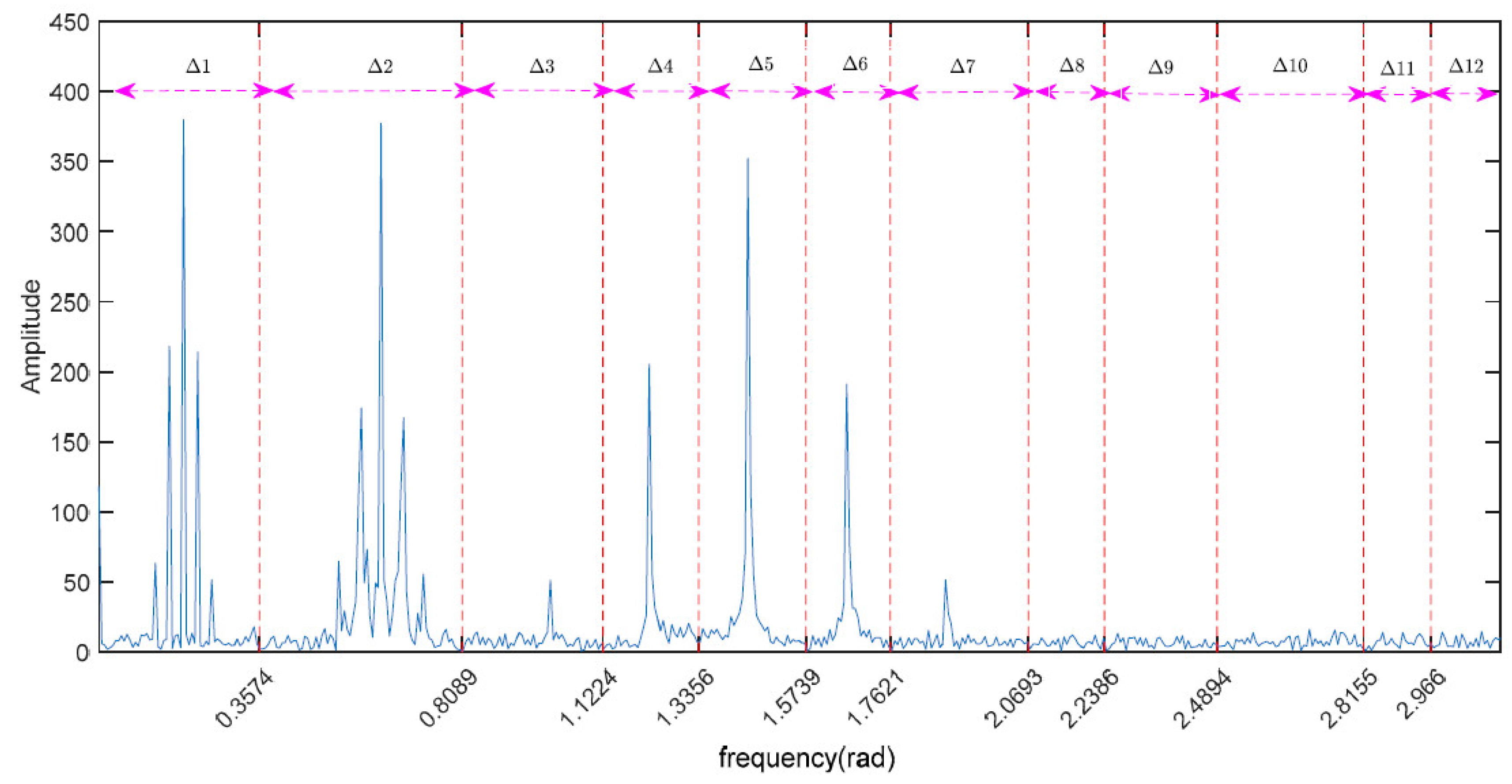


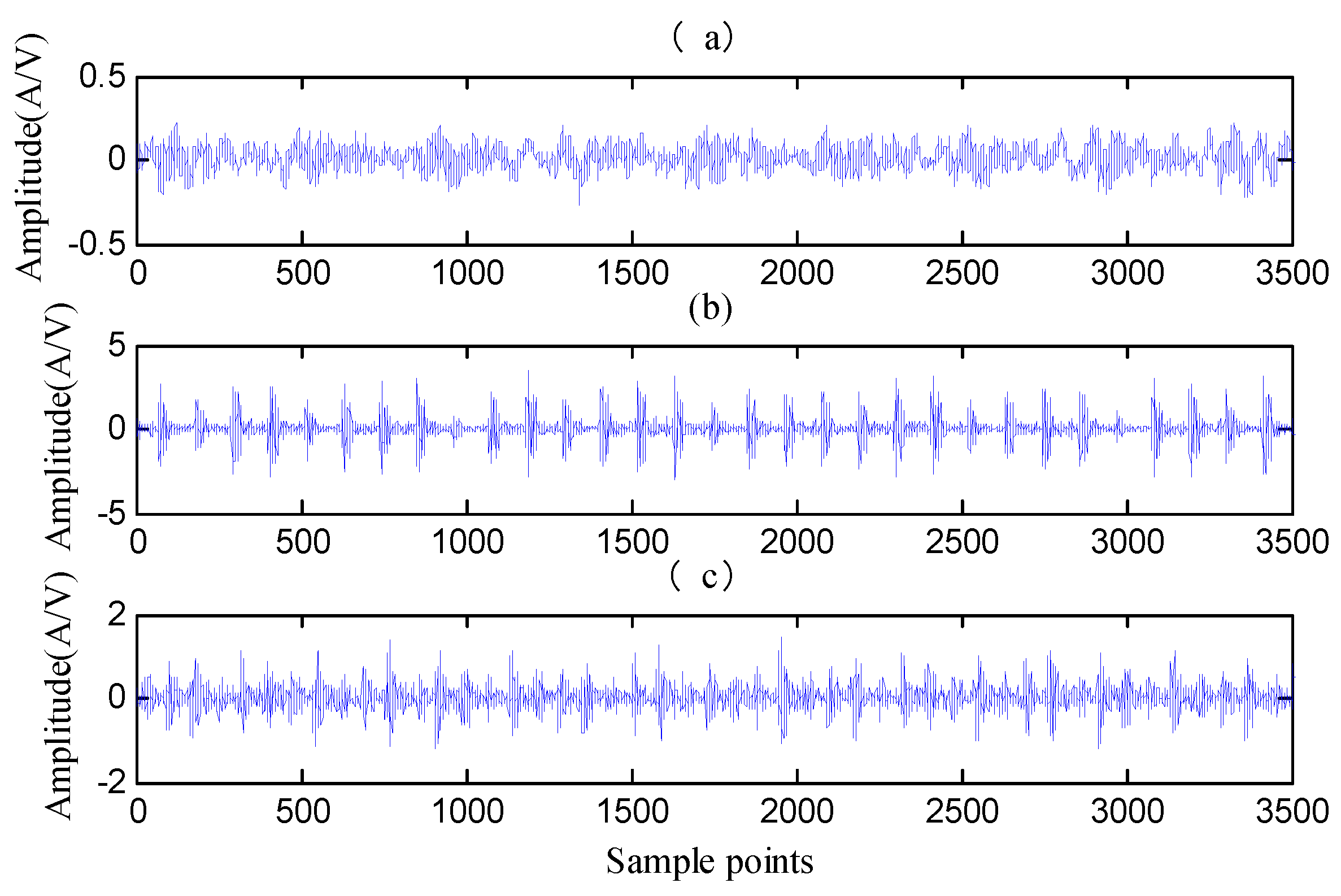
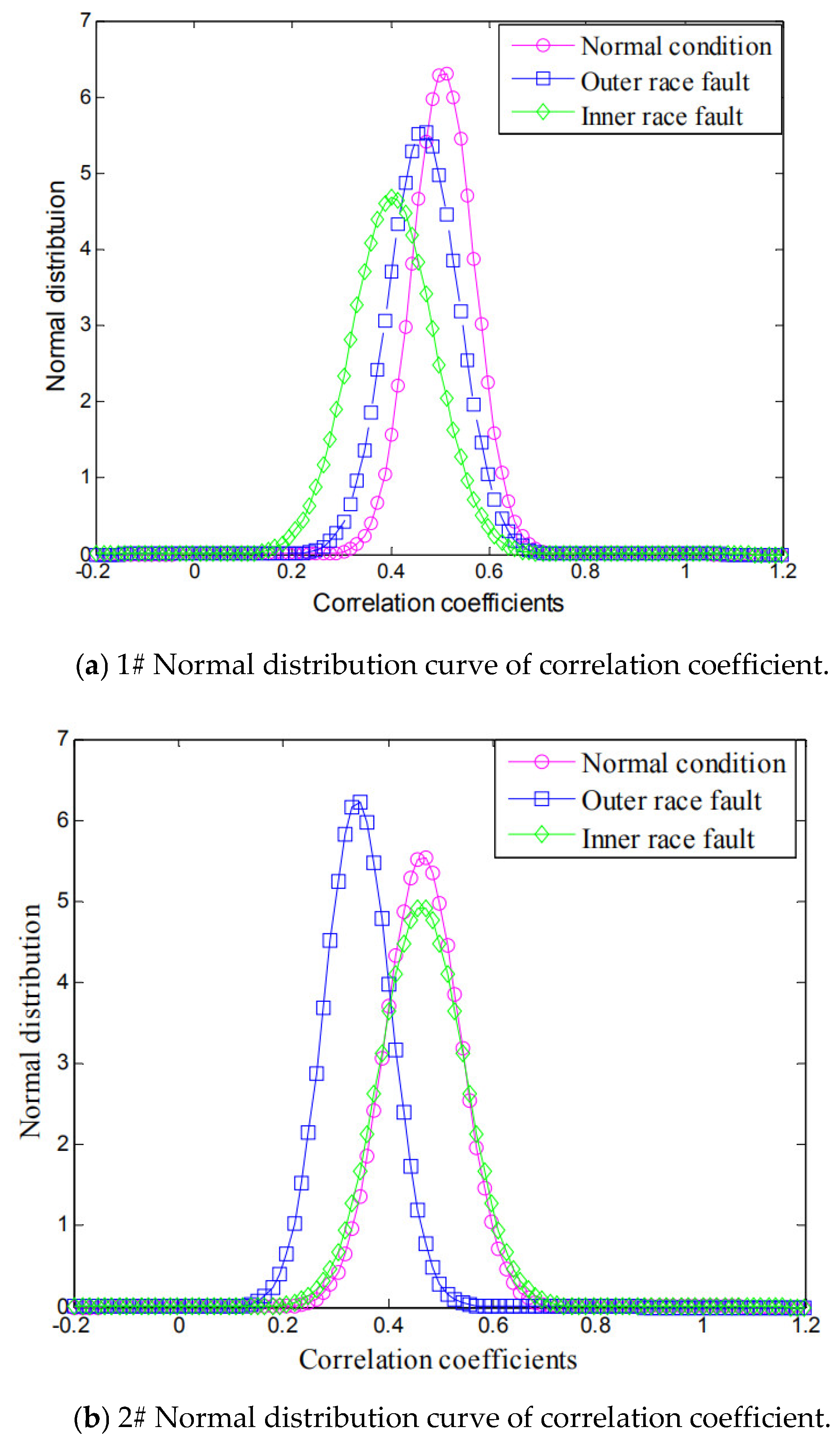
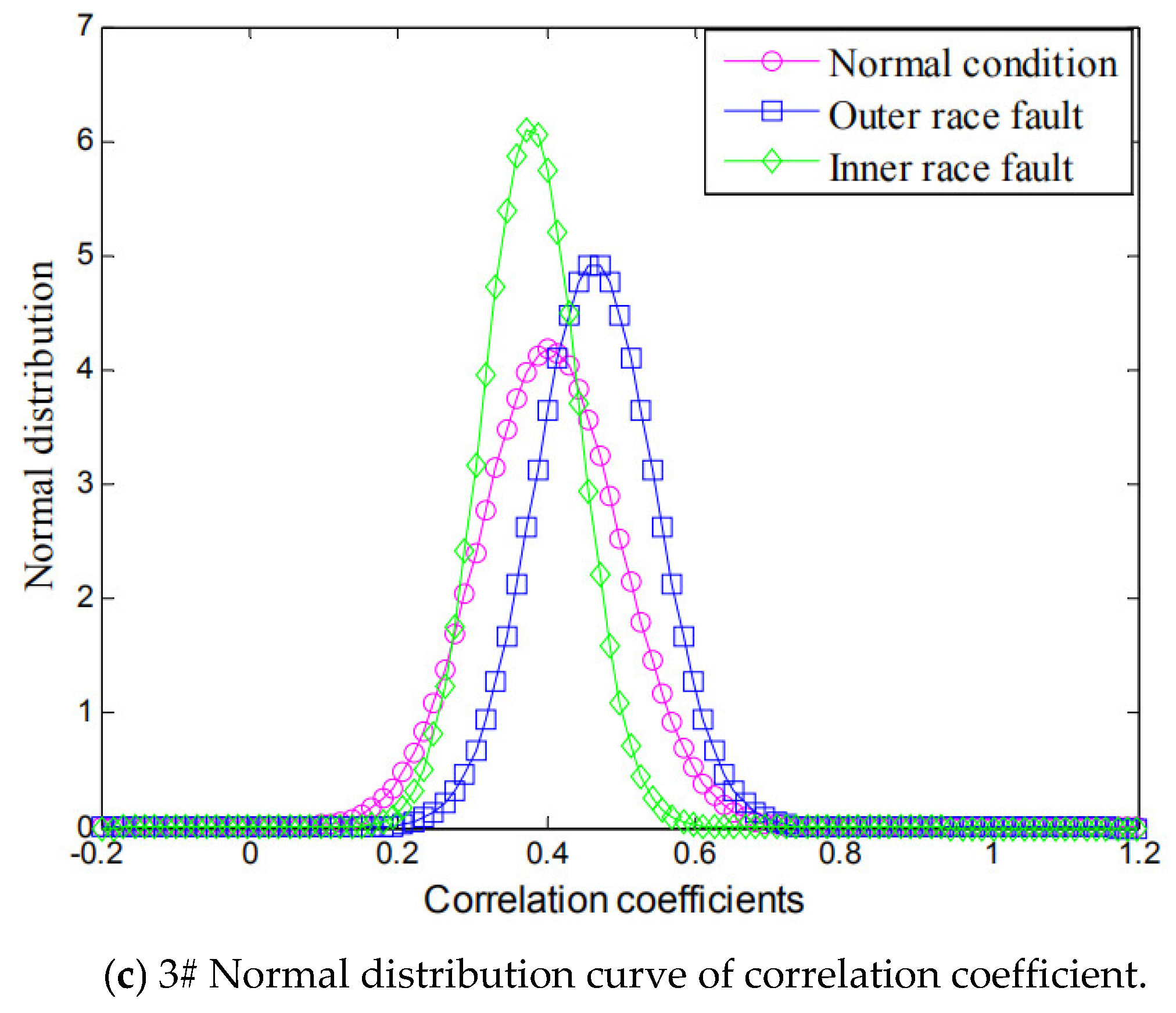
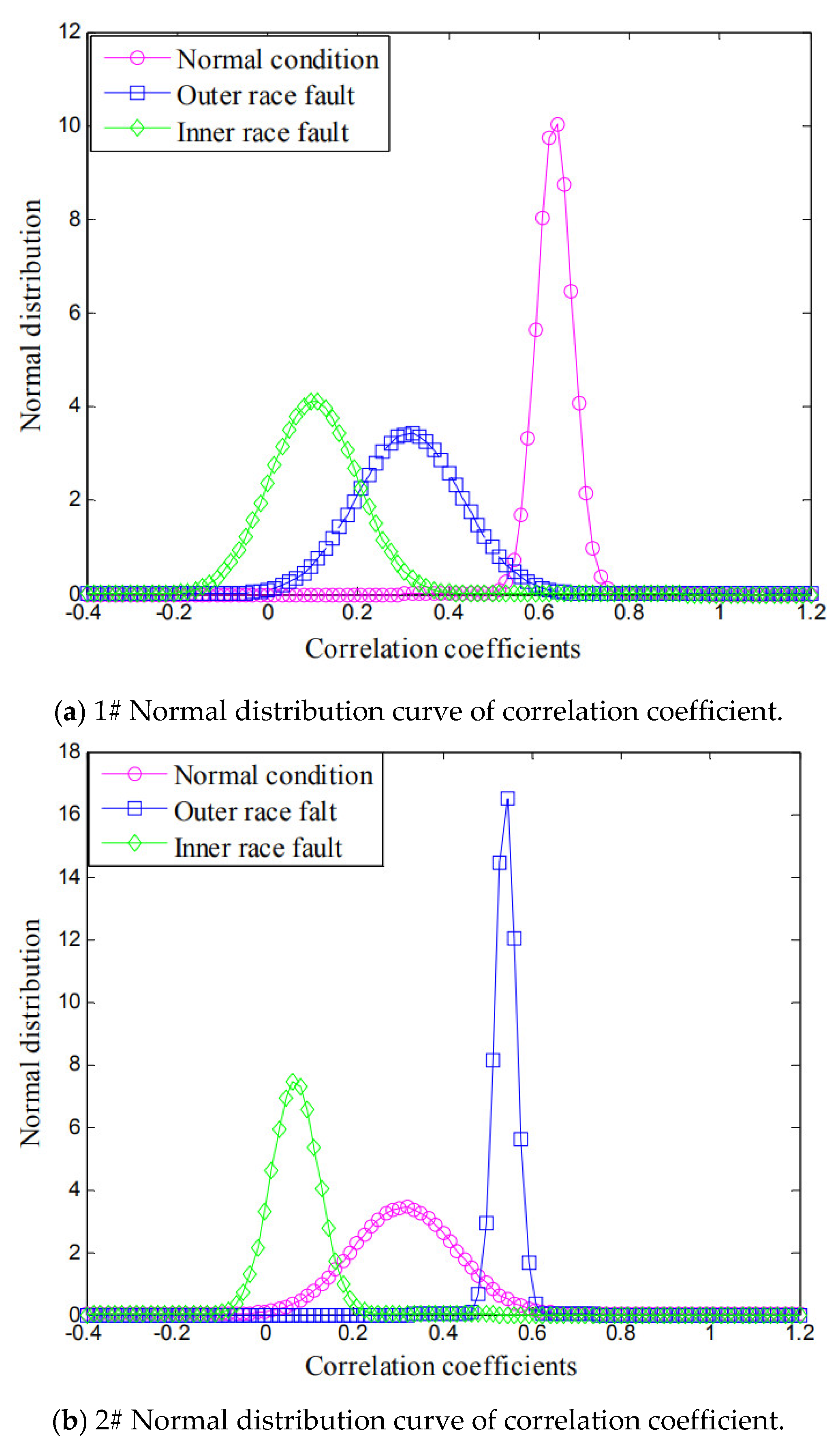

| Modal | Sub-Modal | |||||||
|---|---|---|---|---|---|---|---|---|
| 1 | 2 | 3 | 4 | 5 | 6 | 7 | 8 | |
| F1 | 1 | 1 | 1 | 0 | ||||
| F2 | 0 | 1 | 1 | 1 | 1 | 0 | 1 | |
| F3 | 0 | 0 | 1 | 0 | ||||
| F4 | 1 | 0 | 0 | 1 | 0 | 1 | ||
| F5 | 0 | 1 | 1 | 0 | 0 | 0 | 0 | |
| F6 | 1 | 1 | 1 | 1 | 0 | 1 | 1 | 0 |
| F7 | 0 | 0 | 1 | 0 | ||||
| F8 | 1 | 0 | 1 | 0 | 1 | |||
| F9 | 0 | 1 | 0 | 0 | ||||
| F10 | 0 | 0 | 0 | 1 | 0 | |||
| F11 | 0 | 0 | 0 | 0 | ||||
| F12 | 0 | 1 | 0 | 0 | 1 | 0 | ||
| Original SNR | SNR after Filtering | ||||||
|---|---|---|---|---|---|---|---|
| Median Filter 6 Order | Median Filter 3 Order | Moving Average Filter 5 Point | Moving Average Filter 2 Point | Wavelet Filter Soft Threshold | Wavelet Filter Hard Threshold | EWT Sub-Modal Hypothesis Test | |
| 13.5392 | 3.3115 | 9.3115 | 3.3679 | 13.5392 | 5.9103 | 14.713 | 14.0713 |
| 5.5804 | 1.8441 | 5.6641 | 2.5437 | 5.5804 | 0.3794 | 5.5804 | 7.9106 |
| 0.4700 | 0.4619 | 1.8384 | 1.0831 | 0.4750 | −0.3066 | 0.4750 | 6.1843 |
| −5.5456 | −2.7814 | −3.4708 | −2.4105 | −5.5456 | −2.4269 | −5.5456 | −2.2995 |
| −14.065 | −9.9563 | −11.6723 | −3.2688 | −14.0650 | −8.5990 | −14.0650 | −8.2256 |
| Different Groups | 1# | 2# | 3# | |
|---|---|---|---|---|
| Different Working Conditions | Normal State | Outer Race Fault | Inner Race Fault | |
| Normal state | mean value standard deviation | 0.5074 0.0630 | 0.4664 0.0719 | 0.4042 0.0853 |
| Outer race fault | mean value standard deviation | 0.4664 0.0719 | 0.2415 0.0540 | 0.3650 0.0710 |
| Inner race fault | mean value standard deviation | 0.4042 0.0853 | 0.3650 0.0710 | 0.2789 0.0552 |
| Different Groups | 1# | 2# | 3# | |
|---|---|---|---|---|
| Different Working Conditions | Normal State | Outer Race Fault | Inner Race Fault | |
| Normal state | mean value | 0.7563 | 0.2934 | 0.0925 |
| standard deviation | 0.0235 | 0.1064 | 0.0909 | |
| Outer race fault | mean value | 0.2934 | 0.6407 | 0.0585 |
| standard deviation | 0.1064 | 0.0205 | 0.0493 | |
| Inner race fault | mean value | 0.1025 | 0.0685 | 0.4353 |
| standard deviation | 0.0869 | 0.0494 | 0.0372 | |
| Different Working Conditions | Different Methods | Different Groups | ||||
|---|---|---|---|---|---|---|
| 1# | 2# | 3# | 4# | 5# | ||
| Normal state | The proposed method | 91.5% | 93.6% | 100% | 98.3% | 100% |
| BP | 88.1% | 82.8% | 89.5% | 80.0% | 80.0% | |
| SVM | 87.2% | 83.2% | 88.5% | 80% | 77.8% | |
| Outer race fault | The proposed method | 96.2% | 96.2% | 100% | 98.1% | 100% |
| BP | 88.9% | 82.9% | 82.0% | 84.6% | 80.0% | |
| SVM | 84.5% | 76.0% | 86.1% | 84.6% | 78.2% | |
| Inner race fault | The proposed method | 91.5% | 95.5% | 100% | 98.0% | 100% |
| BP | 77.5% | 82.5% | 87.0% | 84.0% | 85.0% | |
| SVM | 87.5% | 87.0% | 82.2% | 77.5% | 82.0% | |
© 2018 by the authors. Licensee MDPI, Basel, Switzerland. This article is an open access article distributed under the terms and conditions of the Creative Commons Attribution (CC BY) license (http://creativecommons.org/licenses/by/4.0/).
Share and Cite
Ge, M.; Wang, J.; Xu, Y.; Zhang, F.; Bai, K.; Ren, X. Rolling Bearing Fault Diagnosis Based on EWT Sub-Modal Hypothesis Test and Ambiguity Correlation Classification. Symmetry 2018, 10, 730. https://doi.org/10.3390/sym10120730
Ge M, Wang J, Xu Y, Zhang F, Bai K, Ren X. Rolling Bearing Fault Diagnosis Based on EWT Sub-Modal Hypothesis Test and Ambiguity Correlation Classification. Symmetry. 2018; 10(12):730. https://doi.org/10.3390/sym10120730
Chicago/Turabian StyleGe, Mingtao, Jie Wang, Yicun Xu, Fangfang Zhang, Ke Bai, and Xiangyang Ren. 2018. "Rolling Bearing Fault Diagnosis Based on EWT Sub-Modal Hypothesis Test and Ambiguity Correlation Classification" Symmetry 10, no. 12: 730. https://doi.org/10.3390/sym10120730





